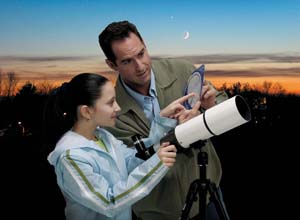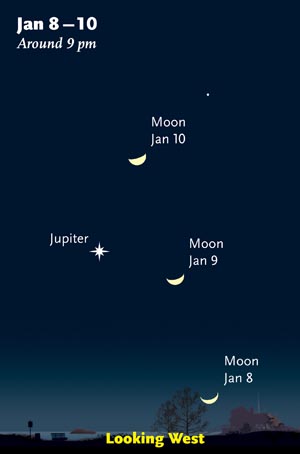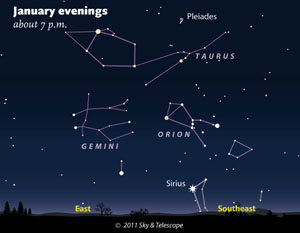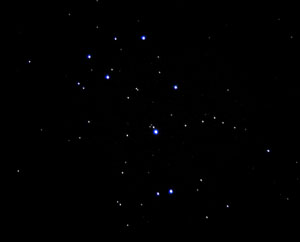January 7, 2011
Contacts:
Alan M. MacRobert, Senior Editor
855-638-5388 x2151, [email protected]
Tony Flanders, Associate Editor
855-638-5388 x2173, [email protected]
Note to Editors/Producers: This release is accompanied by publication-quality graphics; see details at end.
Every holiday season, hundreds of thousands of shiny new telescopes are given to good girls and boys (and moms and dads) around the world. Be it a long, sleek tube or a compact marvel of computerized wizardry, every new telescope surely has an owner itching to try it out. And why wait? Winter evenings often feature crisp, transparent skies with a dazzling canopy of stars. But with so many inviting targets overhead, where should you point first?
"Most telescopes provide fine views of the Moon and bright planets," advises Robert Naeye, editor in chief of Sky & Telescope magazine, "and these are traditionally the first celestial targets tracked down by budding starwatchers." This coming week the Moon is a waxing crescent in the evening sky, and gleaming nearby is the giant planet Jupiter. Both are well placed for prime-time viewing.
Viewing the Moon
The Moon is one celestial object that never fails to impress when seen in a telescope. It’s our nearest neighbor in space — big, bright, beautifully bleak, and just a quarter million miles away. This makes the Moon a wonderful target for even the most humble astronomical instrument. A telescope can keep you busy on the Moon forever.
During mid-January, the Moon is well placed for viewing in the evening sky (full Moon is January 19th). Use your telescope to explore the thousands of impact craters and dark lunar "seas" (vast plains created billions of years ago by lava erupting from the interior). The craters will appear in sharpest relief along the line where lunar day and night meet, called the terminator.
For guided tours of lunar features to seek out with your new telescope, see the online articles Take a Moonwalk Tonight and A Month of Moonwatching.
Jupiter and Its Moons
As soon as the Sun sets, you'll see Jupiter shining brightly high above the southern horizon. Right now this giant planet outshines every star in the nighttime sky. "Jupiter is the king of planets," notes veteran observer Alan MacRboert, a senior editor at Sky & Telescope. "It's big, it's bright, and it has moons that do interesting things." Even at 100×, you should be able to make out a pair of dusky bands girding Jupiter's midsection. These dark equatorial "belts" and the bright "zone" between them are cloud features akin to jet streams high in the Jovian atmosphere. (Jupiter is a gas giant with no solid surface.) You'll see that the southern belt is weaker than its northern sibling. That's because some mysterious process in the planet's atmosphere caused the belt to disappear in early 2010, and only now is it returning to view.
According to MacRobert, larger telescopes (with main mirrors or lenses at least 6 inches in diameter) will bring a few more belts and zones into view, along with an assortment of spots and streaks. The famous Great Red Spot, a huge cyclonic storm larger than Earth, has been rather pale in recent years and can be easily overlooked. Jupiter rotates in just 9 hours, 55 minutes, and the Red Spot is easiest to see when it's crossing the middle of Jupiter's disk.
While watching Jupiter, your eye will immediately be drawn to a series of moons roughly aligned with the planet's "stripes." These are the Galilean satellites, named for the famous Italian astronomer Galileo, who discovered them in 1610. Over time you'll notice their movement as they shuttle around Jupiter. Sometimes not all four moons are visible: occasionally one of them ducks behind Jupiter or is hidden in its shadow. In larger telescopes they (or their shadows) can be glimpsed crossing the planet's disk.
Other Sky Sights
There's more to the night sky than planets, of course, and some of the best celestial treats are on display on January and February evenings. The familiar constellation Orion climbs in the east after sunset. Look for a distinctive trio of bright stars in a nearly vertical line: the Hunter's Belt. Just a few degrees to their south (lower right), you'll find the Orion Nebula, a luminous, swirling cloud of gas and dust where stars are forming by the hundreds. This nebula is obvious in any telescope, and a high-magnification eyepiece should reveal a tight quartet of stars near its center called the Trapezium.
Using the three stars in Orion's Belt, draw an imaginary line to the upper right, past the relatively bright star Aldebaran (the reddish eye of Taurus, the Bull) to a tight knot of stars called the Pleiades. This grouping is also known as the Seven Sisters, and in Japanese it's called Subaru — look for them on this automaker's logo! Through binoculars or a telescope at low magnification, the Pleiades cluster shows dozens of stars. Astronomers have found that the entire cluster has about 500 stars in all.
"To get the most from your new telescope, be patient," advises S&T associate editor Tony Flanders. "Spend time with each object, and get to know it. Much of what the universe has to offer is sublime." Too many first-time telescope users expect an explosion of Hubble-like color through the eyepiece, he explains, when in fact our night vision sees almost everything as shades of gray.
More tips on skywatching and how to get the most out of your telescope can be found in our Observing Section. You can even create a customized sky chart for your location, showing the stars and planets for any time or date.
Sky Publishing (a New Track Media company) was founded in 1941 by Charles A. Federer Jr. and Helen Spence Federer, the original editors of Sky & Telescope magazine. In addition to Sky & Telescope and SkyandTelescope.com, the company publishes two annuals (Beautiful Universe and SkyWatch), as well as books, star atlases, posters, prints, globes, and other fine astronomy products.
Sky & Telescope is making the following photo and illustrations available to the news media. Permission is granted for one-time, nonexclusive use in print and broadcast media, as long as appropriate credits (as noted in each caption) are included. Web publication must include a link to SkyandTelescope.com.scope.com.

New-telescope owners are eager to see the night sky's amazing vistas. Even a small one can show you craters on the Moon, Jupiter and its moons, star clusters, nebulas, and more. Click on the image to view or download a publication-quality version.
Sky & Telescope Craig Michael Utter

The planet Jupiter shines brightly in the evening sky this winter. Jupiter and the Moon make fine targets for new telescopes unwrapped during the holidays. To find them, face west in early evening and match this chart to the star patterns you see in the sky. Click on the image to view or download a publication-quality version.
Sky & Telescope: Gregg Dinderman

Use the easily recognized stars of Orion as your waypoint for finding other stars and constellations in the eastern evening sky. To find them, face east in early evening and match this chart to the star patterns you see in the sky. Click on the image to view or download a publication-quality version.
Sky & Telescope: Gregg Dinderman

Click on this image to see a time-lapse sequence showing the motion of Jupiter's four Galilean satellites (Io, Europa, Ganymede, and Callisto) over 1½ hours. Note the rotation of Jupiter itself during this sequence — the giant planet rotates in just under 10 hours.
Animation by António Cidadão; courtesy Sky & Telescope.

The Pleiades star cluster is a splendid target for small telescopes, which show dozens of its stars in an attractive grouping. Astronomers estimate that the cluster formed less than 100 million years ago. Located in the constellation Taurus, the Bull, the Pleiades lie about 400 light-years from Earth. This photo was made with an 85-mm (3.3-inch) Tele Vue refractor and a Canon digital camera. Click on the image to download a (publication-quality version).
Sky & Telescope photograph by Rick Fienberg.
 0
0
Comments
You must be logged in to post a comment.